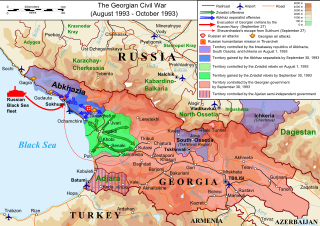
The Georgian Civil War lasted from 1991 to 1993 in the South Caucasian country of Georgia. It consisted of inter-ethnic and international conflicts in the regions of South Ossetia and Abkhazia, as well as the violent military coup d'état against the first democratically-elected President of Georgia, Zviad Gamsakhurdia, and his subsequent uprising in an attempt to regain power.
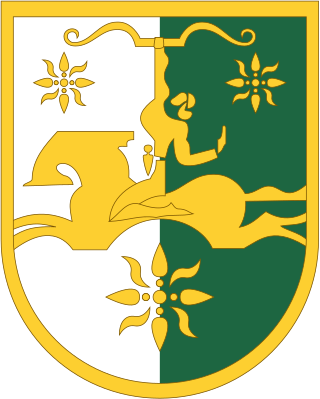
Politics in Abkhazia is dominated by its conflict with Georgia. Abkhazia became de facto independent from Georgia after the 1992–1993 war, but its de jure independence has only been recognised by a few other countries. Abkhazia is a presidential representative democratic republic with a multi-party system, wherein the President is both head of state and head of government. Executive power is exercised by the government of the Republic of Abkhazia. Legislative power is vested in both the government and the People's Assembly of Abkhazia.
The Kodori Valley, also known as the Kodori Gorge, is a river valley in Abkhazia, Georgia's breakaway autonomous republic. The valley's upper part, populated by Svans, was the only corner of the post-1993 Abkhazia directly controlled by the central Georgian government, which since 2006 officially styles the area as Upper Abkhazia. On August 12, 2008, Russo–Abkhazian forces gained control of the Upper Kodori Valley, previously controlled by Georgia.

The Abkhazia conflict is a territorial dispute over Abkhazia, a region on the eastern coast of the Black Sea in the South Caucasus, at the intersection of Eastern Europe and Western Asia. The conflict involves Georgia, Russian Federation and Russian-backed self-proclaimed Republic of Abkhazia, internationally recognised only by Russia, Venezuela, Nicaragua, Nauru, and Syria; Georgia and all other United Nations members consider Abkhazia a sovereign territory of Georgia. However, as of 2023, Georgia lacks de facto control over the territory.

Zhiuli Shartava was a Georgian politician and National Hero who served as the Head of the Government of the Autonomous Republic of Abkhazia and was killed by Abkhaz militants during the ethnic cleansing of Georgians in Abkhazia in 1993.

The ethnic cleansing of Georgians in Abkhazia, also known in Georgia as the genocide of Georgians in Abkhazia, refers to the ethnic cleansing, massacres, and forced mass expulsion of thousands of ethnic Georgians living in Abkhazia during the Georgian-Abkhaz conflict of 1992–1993 and 1998 at the hands of Abkhaz separatists and their allies. Armenians, Greeks, Russians, and opposing Abkhazians were also killed.
The Sukhumi massacre took place on 27 September 1993, during and after the fall of Sukhumi into separatist hands in the course of the War in Abkhazia. It was perpetrated against Georgian civilians of Sukhumi, mainly by militia forces of Abkhaz separatists and North Caucasian allies. It became part of a violent ethnic cleansing campaign carried out by the separatists.
The Government of the Autonomous Republic of Abkhazia is an administration established by Georgia as the legal and only government of Abkhazia. Abkhazia has been de facto independent of Georgia – though with limited international recognition – since the early 1990s. Ruslan Abashidze, elected in May 2019, is the current head of the government-in-exile.

The history of Abkhazia, a region in the South Caucasus, spans more than 5,000 years from its settlement by the lower-paleolithic hunter-gatherers to its present status as a partially recognized state.
The Bagramyan Battalion, also known officially as the Independent Motorized Rifle Battalion named after Marshal Ivan Khristoforovich Baghramyan was a unit formed in Abkhazia and predominantly composed of ethnic Armenians living in Abkhazia that fought together with Russia backed separatist Abkhaz forces during the War in Abkhazia (1992–93). Named in honour of the Soviet Armenian Marshal Ivan Bagramyan, the battalion fought against the forces of Georgia. It was subsequently disbanded. It is considered a terrorist organisation by many international research organizations and Georgia.
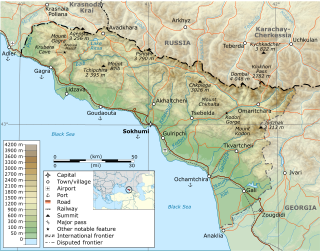
The War in Abkhazia was fought between Georgian government forces for the most part and Abkhaz separatist forces, Russian government armed forces and North Caucasian militants between 1992 and 1993. Ethnic Georgians who lived in Abkhazia fought largely on the side of Georgian government forces. Ethnic Armenians and Russians within Abkhazia's population largely supported the Abkhazians and many fought on their side. The separatists received support from thousands of North Caucasus and Cossack militants and from the Russian Federation forces stationed in and near Abkhazia.
The Battle of Gagra was fought between Georgian forces and the Abkhaz secessionists aided by the Confederation of Mountain Peoples of the Caucasus (CMPC) militants from 1 to 6 October 1992, during the War in Abkhazia. The allies, commanded by the Chechen warlord Shamil Basayev, captured the town of Gagra from the undermanned Georgian forces in a surprise attack, leading to an outbreak of ethnic cleansing of local Georgian population. The battle proved to be one of the bloodiest in the war and is widely considered to be a turning point in the Georgian-Abkhaz conflict. The action, in which Russian commanders were suspected to have aided to the attackers, also resulted in a significant deterioration of the Georgian-Russian relations.

The Kamani Massacre took place on July 9, 1993, during the Georgian-Abkhaz conflict. It was perpetrated against Georgian inhabitants of Kamani, mainly by militia forces of Abkhaz separatists, and their North Caucasian and Russian allies. It became a part of the bloody campaign carried out by the separatists, which was known as the ethnic cleansing of Georgians in Abkhazia

The Abkhazian Armed Forces are the military forces of Abkhazia. The forces were officially created on 12 October 1992, after the outbreak of the 1992–1993 war with Georgia. The basis of the armed forces was formed by the ethnic Abkhaz National Guard. The Abkhaz military is primarily a ground force but includes small sea and air units. According to the authorities of the Republic of Abkhazia, the Abkhazian Land Forces are organised along the Swiss model – in time of peace they have personnel of 3,000 to 5,000 and in case of war further 40–50,000 reservists are called out. Georgia regards the Abkhaz armed forces as "unlawful military formations" and accuses Russia of supplying and training the Abkhaz troops.
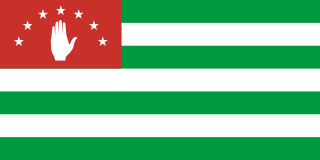
Abkhazia officially the Republic of Abkhazia, is a partially recognised state, in the South Caucasus, on the eastern coast of the Black Sea, at the intersection of Eastern Europe and Western Asia. It covers 8,665 square kilometres (3,346 sq mi) and has a population of around 245,000. Its capital and largest city is Sukhumi.
Giorgi (Gia) Karkarashvili is a Georgian politician and retired major general who served as Georgia's Minister of Defense from May 1993 to March 1994. A former Soviet army captain, he was a high-profile military commander during the civil war and wars against the secessionists in Abkhazia and South Ossetia in the 1990s. A gunshot wound received in the 1995 attack in Moscow left him severely disabled. He was a member of the Parliament of Georgia from 1999 to 2004. He is currently a member of the Our Georgia – Free Democrats party led by Irakli Alasania.
The War in Abkhazia from 1992 to 1993 was waged chiefly between Georgian government forces on one side, Russian military forces on other side supporting separatist forces demanding independence of Abkhazia from Georgia. http://www.historyorb.com/russia/georgia.php Ethnic Georgians, who lived in Abkhazia fought largely on the side of Georgian government forces. Ethnic Armenians and Russians within Abkhazia's population, largely supported Abkhazians and many fought on their side. The separatists were supported by thousands of the North Caucasus and Cossack militants and by the Russian Federation forces stationed in and near Abkhazia.
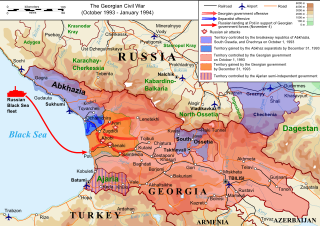
The Battle of Poti was a series of engagements around Poti, Georgia during the Georgian Civil War, between rebels supporting the ousted Georgian president Zviad Gamsakhurdia, the so-called 'Zviadists', and Russian forces supporting the Georgian Head of State Eduard Shevardnadze. A group of Russian Marines of the Black Sea Fleet landed in the Georgian port city in late October 1993 to protect an important railway between Poti and the Georgian capital Tbilisi. In November clashes between the Russians and the Zviadists erupted, with the Russian Major General Boris Djukov, claiming no Russian casualties. The fighting ended when the Georgian Armed Forces broke through the rebels' defenses and entered their capital Zugdidi on the 6th of November.
The Battle of Gumista was a battle between Georgian armed forces and Abkhaz separatists. It was the bloodiest clash of the Abkhaz–Georgian conflict and the War in Abkhazia. It was held on March 15–16, 1993 along 8 kilometres (5.0 mi) of the banks of the Gumista River.










